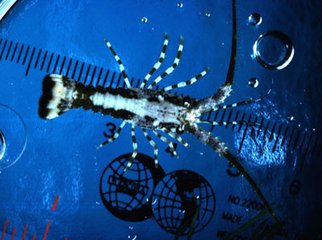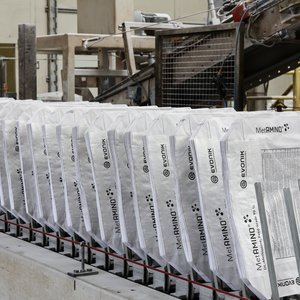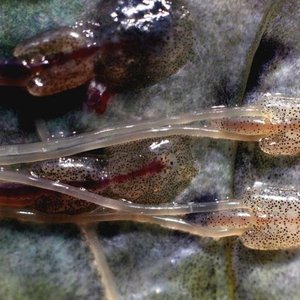Harbor Branch scientists have received new funding for a research program they hope will make large-scale culturing of spiny lobster economically feasible. Research on lobster feeds is running concurrently
Harbor Branch scientists have received new funding for a research program they hope will make large-scale culturing of spiny lobster economically feasible. The project is based on the serendipitous discovery that lobster larvae are settling on open water fish cages in Puerto Rico by the thousands.
"Spiny lobsters are one of the most highly-prized fisheries species in the world, and especially in our Florida waters," said Megan Davis, director of Harbor Branch's aquaculture program. "Our research at Harbor Branch is very exciting because we expect to make breakthroughs in diet development and growout of juveniles that will help to make the culture of this species a reality, " she said.
Spiny lobster is an ideal target for commercial culture due to its high value and limited availability from wild capture, mostly using traps. Each year, 3 to 4 million pounds of Florida spiny lobsters valued at about $17 million are harvested and account for 11% of the spiny lobsters on the U.S. market. Overfishing of lobster has also led to ecological problems in some areas that might be relieved through successful culture and release to the wild.
The main barrier to successful commercial spiny lobster culture, which has been explored through pilot programs in various countries, has been the need to collect larvae from the wild. The lobster larval growth cycle is extremely complicated and as yet reproduction and growth to adulthood has not been accomplished in captivity in reliable numbers.
Development of collection methods to get enough larvae to support large-scale commercial culture has so far not been possible, but in 2003 technicians with Puerto Rico- based Snapperfarm, Inc., discovered that lobster larvae by the thousands happened to be settling on large submerged cages the company uses to raise fish. The cages, anchored in 100 feet of water, are about 50 feet high by 80 feet in diameter, making for a total of 12,000 square feet of lobster larvae-snagging surface area.
In 2004, with $50,000 in funding from the National Oceanic and Atmospheric Administration's Small Business Innovation Research program, the company began working with Harbor Branch's aquaculture program and other groups to determine if commercial-scale quantities of larvae could be collected from the cages.
The team found that up to 400 larvae per month could be collected--enough for testing commercial feasibility of raising the lobsters to market size. They have now received Phase II funding from NOAA for two years totaling $200,000 to explore techniques for gathering even more larvae, to study open water and land-based methods for raising the larvae to adulthood, and to begin developing possible feeds for the lobster. Small-scale lobster culturing has been possible using cast off parts of conch and other species from seafood processing plants and elsewhere, but this is not an economic option at larger scales. A final goal of the new project will be to determine if increased availability of lobster might make higher-value options, such as selling live lobster or whole lobster, possible.
Over the next six months, scientists from Harbor Branch, Snapperfarm, the U.S. National Marine Fisheries Service in Puerto Rico, the Florida Sea Grant Program in Ft. Pierce, and the University of Miami will be working in Puerto Rico to construct lobster larvae collectors and determine the best design and placement locations on the cages; to set up submerged lobster enclosures and refuges referred to as casitas for raising juveniles; and to begin raising lobster in troughs on land. Work to develop a lobster feed that could ultimately be marketed to a lobster aquaculture industry is running concurrently at Harbor Branch.














